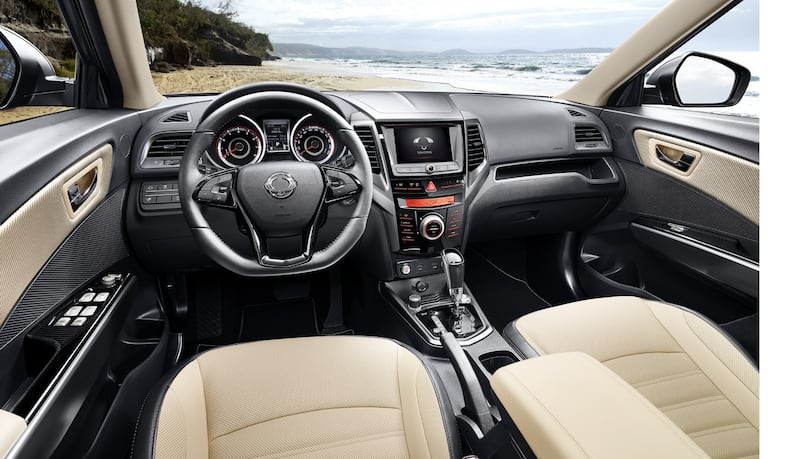It can’t be easy to gain some brand traction for a car maker that most people have never heard of. Harder still in the Irish market, where customers are notoriously loyal and where a few brands chew up a huge percentage of the market between them and leave precious few crumbs for the rest.
Ssangyong though, is having a good go at it, and the Harris Group, which oversees the brand in Ireland, is sanguine about its chances.
Joe Harris, chief executive of Ssangyong Motors Ireland, told The Irish Times that "we do have to work very hard at it, and it's certainly not easy. The key thing is to have a well-trained and motivated sales force, people who can explain to potential customers what the car is about. I think, as with so many cars, once you can get people to test drive it, it's a lot easier, because then they can see."

Good product helps too, and Ssangyong is starting to follow the now well-worn path from bargain bucket to respectability, as trod by its fellow Koreans, Hyundai and Kia.
The Tivoli was really the first new product from Ssangyong that could cut it with the big boys of the crossover world, and it has been something of a success here in Ireland. This XLV should help to expand that, but perhaps not in the way you might think.
You think it’s a seven-seater, don’t you? The “XL” tag, the raised roofline at the rear, the general sense of extra bulk, all point to an extra row of folding seats. But they’re not there, instead you get an enlarged boot, with a massive 720 litres (if you forego a spare wheel) or 574 litres if you want the spare.
Why not the seven-seat option? Well, it might be that there will be one at some point (and you can certainly detect some tacit frustration among the Ssangyong Ireland people that the third row is absent) but the main reason seems to be that Nissan has dropped its +2 model of the Qashqai, and Ssangyong decided that without a direct competitor, there wasn’t much point.
Styling
At least the Tivoli XLV has looks on its side. Well, mostly. At the front it looks good anyway, a touch generic, but nice with its LED running lights and new bumper. The floating-effect roof looks good too, but the styling touch is lost around the back, where with the extra bulk it all goes a bit Rodius. And no, that’s not a compliment.
The inside’s not bad though. Okay, so the plastics are mostly hard, shiny and scratchy and generally look like the kind of stuff Hyundai and Kia abandoned nearly two decades ago, but things such as the leather- wrapped steering wheel and the main instruments are actually pretty nice, while the sat-nav that comes with top-spec EL versions is good too.
And it’s roomy. Ssangyong has squeezed a little more legroom and a lot more headroom (compared to the standard Tivoli) into the back, and it’s pretty comfy too. Up front, the driver’s seat feels a little pinchy across the shoulders, and the driving position a bit perched up, but it’s not bad at all. And yes, the boot, even with a spare wheel under it, is massive.
It almost goes without saying that there’s plenty of standard equipment, a classic lure for customers for an up-and-coming bargain brand, albeit a harder sell these days when the mainstream brands are generally becoming better equipped.
The €24,750 for a basic ES includes single-zone climate control, iPod connectivity, parking sensors, LED running lights and Bluetooth, while upgrading to the €28,995 EL gets you a sunroof, dual-zone climate, heated front and rear seats, an upgraded instrument cluster and the option of a three-pin power socket in the boot. Not bad, but perhaps not enough to put clear blue water between it and a rival Qashqai in equipment terms.
Upgrade
In driving terms, it’s fine, verging on being “surprisingly good”. The 115hp 1.6 litre diesel engine is a touch noisy at times, although nowhere near as bad as you might have expected, and it’s willing and pulls well with its 300Nm of torque.
You can get four-wheel drive, but it means upgrading to a €31,000 model, so for most of us it’s not going to be worth it. I’d also avoid the optional automatic gearbox, as it pushes the C02 figure from a near-saintly 117g/km for the manual model to 154g/km, more or less doubling your annual motor tax bill.
The steering is rather light and free of feel, but turn it to Sport mode (something of a misnomer in these circumstances, perhaps) and it weights up a bit, and the Tivoli feels never anything less than pleasingly sure-footed. Really sharp bumps and obstacles will send a big whump up through the suspension, but actually the ride quality is quite well-judged, added to which the Tivoli’s square shape and good visibility means it should make a decent in-town companion.
For all its SUV styling and its optional all-wheel drive, that’s probably where most will spend their actual lives.
It’s not quite as arrestingly cheap as the €21,000 standard Tivoli, and while I love big boots you can’t deny that it’s a shame that there’s no extra seats, however small and “occasional” they may have been. It does rather take away from the point of buying a Tivoli XLV.
Practical
If you really, really need the extra boot volume, then delete the spare wheel option and go for the cheapest one available, at which point it makes a roomy, practical, pleasant and well-priced alternative to the likes of a Qashqai or Renault Kadjar.
For most of us, the even-cheaper standard model would probably make for a better option.
The lowdown: Ssangyong Tivoli XLV EL
Engine: 1,600cc, 115hp; manual tranmission
Torque: 1300Nm
Top speed: 170km/h
Claimed economy: 4.5-litres per 100km (62mpg)
CO2 emissions: 117g/km
Motor tax: €200
Price: €28,995 as tested










